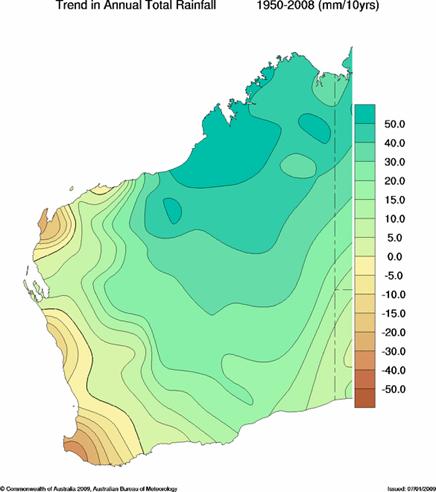| Article Index |
|---|
| Our climate |
| Projected changes in our climate |
| All Pages |
Observed changes in our climate
Like global temperatures, WA temperatures have also increased since 1910. The strongest trend has been observed since the 1950s (Figure 2), though in the far north of WA there has been a slight cooling in average temperatures. Across the state as a whole, mean annual temperatures have increased since 1910 by approximately 0.8ºC.

Figure 2 Trend in annual mean temperature 1950-2008 (BoM (b), 2009)
In southwest WA, a drying trend has been observed (Figure 3). The rainfall decline has been most apparent in late autumn and early winter, with a major drop in rainfall totals occurring in the 1970s, and possibly another more recently in the 1990s. Averaged across southwest WA, a step decrease in total annual rainfall of almost 10% was seen in the mid-1970s, though individual locations would have experienced a greater decrease.

Figure 3 Trend in annual rainfall from 1950-2008. These maps are interpolated from high quality station data (BoM (c), 2009)
For more information on observed changes in WA's and Australia's climate, go to the Bureau of Meteorology's Climate website.
Fact sheet: How WA's climate has changed
IOCI Stage 3 is currently building on past knowledge to improve our understanding of what causes changes to rainfall over south-west and north-west WA.
Update to October 2010
- See Update on IOCI Research: WA Rainfall - What the past can tell us and what the future may hold
Projected changes in our climate
In the southwest of WA, rainfall has already decreased and is projected to continue decreasing throughout this century. Future increases in temperature and potential evaporation are also anticipated; however, predicting impacts of global climate change at a regional and local level is difficult.
The Indian Ocean Climate Initiative (IOCI) research program has been studying the climate of WA's southwest since 1998. Projections under all scenarios and all models point to drier conditions across the southwest in the future.
The current global climate models all agree on the direction of change in winter (June to August) across the southwest with a mean reduction in southwest WA's winter rainfall of approximately 20 percent predicted (Figure 1). Results from IOCI research for southwest WA projects that relative to 1960-1990 (Bates et al, 2008):
- By 2030, rainfall will decrease by between 2 to 20 percent;
- By 2030, summer temperatures will increase by between 0.5 to 2.1 degrees C;
- By 2030, winter temperatures will increase by between 0.5 to 2.0 degrees C;
- By 2070, rainfall will decrease by between 5 to 60 percent;
- By 2070, summer temperatures will increase by between 1.0 to 6.5 degrees C; and
- By 2070, winter temperatures will increase by between 1.0 to 5.5 degrees C.

Figure 1. Projected precipitation changes for 2030 relative to 1960–1990 as determined by runs from nine international climate models forced by the full range of the SRES scenarios and the 550 ppm and 450 ppm stabilization scenarios (Bates et al, 2008)
Fact sheet: The future of WA's climate
IOCI Stage 3 is improving our knowledge of future rainfall patterns over south-west and north-west WA. Research into the predictability of rainfall and efforts to improve climate models will provide useful information for climate-dependent industries such as agriculture.
Update to October 2010
- See Update on IOCI Research: WA Rainfall - What the past can tell us and what the future may hold




 Our Climate
Our Climate